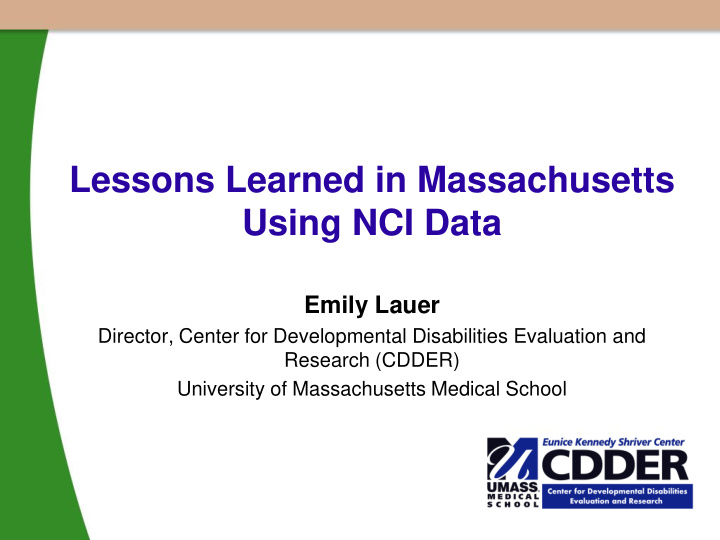



Lessons Learned in Massachusetts Using NCI Data Emily Lauer Director, Center for Developmental Disabilities Evaluation and Research (CDDER) University of Massachusetts Medical School
Use of Info in the Quality Improvement Cycle Identifies area for Collected Data – like attention National Core Indicators Quality Confirm/Explore in Monitor impact Improvement other info sources Cycle or broader review Aids understanding of depth of issue, Develop & Implement and targets for Intervention action
Tips – using data for systemic improvement • Triangulate when possible • Use benchmarks, select carefully • When is a difference really a difference? • Consider a range of audiences in how “data” is presented to ensure it’s understood and useful • Be sure to engage discussion, don’t just show/tell
Reporting & Dissemination Products • MA has been using NCI data to report to stakeholders starting with data from 2001-2002. • Early stage: Prepared an annual Quality Assurance Report o Aggregated and analyzed multiple sources of data to offer different perspective of several outcomes and indicators of quality • Enabled open conversations about strengths and weaknesses of the service system involving a range of stakeholders, state staff and other voices. • Data used: NCI data, survey and certification of provider agencies, medication administration records, investigations, critical incidents, restraints and others!
Evolution of Reporting • Early Reporting o Highly informative o Format was dense, had a LOT of info (80 pgs!) o Challenge to get to the main takeaways o Stage 2 of Reporting: Briefs o 1 topic per brief, issued throughout the year o More emphasis on simple, understandable presentation
Evolution of Reporting • Stage 3 – Infographics o Format used to focus on the main findings o Didn’t require the reading of as much text o “At -a- glance” reading style o Tested with a variety of stakeholders • Allowed for a more focused, engaged conversation across stakeholders Let’s look at some examples…
Acting on the findings • Loneliness finding was an important launching ground for a social inclusion initiative • Findings were presented to MA DDS’s Quality Council that includes varied stakeholders • Impact of efforts in this area are being tracked
Quality is No Accident Briefs • Started in 2010 • Audience: House Managers, Service Coordinators, Families • Briefs of topical focus o Identify risks, strategies to manage the risks, and data about the topic o Includes “Did you know?” facts to help inform and dispel misconceptions.
Example Brief
Topics to date… • • Aging with Intellectual and Dysphagia, Aspiration, and Developmental Disability (IDD) Choking • • Alzheimer's and Dementia Preventable Hospital Use: Dehydration, Constipation, and • Age-related Health Issues Urinary Tract Infection • Friendships in People with • Constipation and Bowel Intellectual Disabilities Obstruction • Sexuality • Oral Health • Safe Transportation of People in • Preventive Health Screenings Wheelchairs • Medication Errors • Emergency Room and Urgent • Care Strategies Missing Persons • • Ingestion of Foreign Objects Falls (Pica) https://shriver.umassmed.edu/programs/cdder/dds-quality-assurance-reports
Webinars • Benefits of format o Allows for live participation and interaction o Questions, audience polling, knowledge check questions, etc. Recorded and closed captions – creates longer- o term, accessible resource o Slide-supported narrative presentation allows for more in-depth discussion of certain risks/strategies
Webinars • Additional Benefits: o Can provide different sections of content for different audiences o Can be used in train-the-trainer format to ensure consistent messaging. o Affordable, efficient, effective. o Users can revisit/refresh training as needed.
Tips • If using slides as a background, keep it interesting for visual users o Frequent movement on the screen tied to content, highlighting of concepts on slides Use images – not just text o Don’t overdo it - avoid too many distracting slide o transitions • In developing content: Consider your audience in balancing content – ex. o make content understandable for non-clinicians, but informative enough for clinicians
Tips (cont.) • For live webinars being recorded: o Test sound/setup before beginning o Encourage users to type in questions to assist with smoother Q&A section ▪ Some questions are best answered outside of a live webinar format o Use caution (and testing!) with videos to assess bandwidth issues, especially with larger webinars o Employ sound-managing tools to mute listener phone lines as needed, etc.
Topics to date… • Human Rights: What • Best Practices for Supporting Families Need to Know People in the ER/Advocacy • Mandated Reporting of • Falls Prevention and Abuse and Mistreatment Intervention • Safe Transportation of • Oral Health Practices People who use Wheelchairs • Dysphagia, Aspiration, and • Widening the Circle: Choking Expanding Opportunities for • Constipation and Bowel Friendship Obstruction • Psychotropic Medications • Pica and the Ingestion of and Side Effects Non-Food Items • Hospice/Palliative Care: What are they? https://shriver.umassmed.edu/programs/cdder/dds-webinars
Thank you! Emily Lauer, MPH Director, Center for Developmental Disabilities Evaluation and Research (CDDER) Eunice Kennedy Shriver Center University of Massachusetts Medical School 55 Lake Avenue North, S3-301 Worcester, MA 01655 Emily.Lauer@umassmed.edu 774-455-6563
Recommend
More recommend